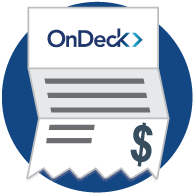Advertiser & Editorial Disclosure
 OnDeck APR Calculator
OnDeck APR Calculator
OnDeck is one of the largest lending platforms for small business loans. They offer both term loans and lines of credit. Term loans are offered from $5,000 – $500,000 with various payback periods between 3 – 36 months. You pay your loan back with either fixed daily or weekly payments. Lines of credit are offered up to $100,000 and you only pay interest on what you draw (however there is monthly maintenance fee for lines of credit).
Their business loan fee structure is slightly different from that of a traditional term loan you’d find at a bank, so be sure to use the calculator below to calculate the annual percentage rate of your loan. According to the OnDeck site, the average interest rate for their business loans is 24.6%, or 42.5% annual interest rate, which is the annual interest rate excluding origination fees.
You may be wondering, “is 24.6% interest normal for an average interest rate on a business loan?” Alternative business loan options do often come with a higher price tag than bank loans. Learn more about what to expect from online business loan options here.
Add the OnDeck APR Calculator to your website, copy & paste the code below
<!-- Start https://www.nav.com OnDeck APR Calculator --> <div id="embedded-calc" class="embedded-calc"> <div class="powered-by">Powered by <a href="https://www.nav.com">nav</a></div> </div> <script src="https://www.nav.com/calculators/embed_ondeck_calc.js"></script> <!-- End https://www.nav.com OnDeck APR Calculator -->
OnDeck Loan Offers
Line of Credit by OnDeck
How to Use the OnDeck APR Calculator
Business financing is a bit different than term loans most consumers are familiar with, like fixed-rate mortgages or auto loans. Your APR is determined by a few key data points you’ll see on your offer sheet — the total loan amount, origination fee, the total amount you’ll eventually pay back to the lender once the loan has run its course, and the number of payments you’ll make.
If you don’t understand where to find these numbers, you should call the customer support line or speak to your loan officer. You should never take out a loan without fully understanding the terms.
What’s the Difference Between APR & Interest Rate?
You may have heard “annual percentage rate” and thought that “interest rate” was just a simpler way of saying that. In fact, the two terms are often conflated, but have a significant difference that is key for business owners to understand so they can compare loans properly. An APR takes any fees associated with the loan (like origination fees) and wraps them up into a (higher) percentage rate than the interest rate you may see quoted.
APRs are generally a better way to calculate loan costs because they allow you to easily compare loans with different fee structures.
How Do I Get a Lower APR?
Origination fees for business loans have little wiggle room with lenders (though it never hurts to ask — they want your business too!), so lowering your interest rate is key to getting a better APR.
One of the biggest factors in the interest rates and APRs you’re offered is often your business credit score or personal credit score if you’re giving a personal guarantee for the loan. Errors on your personal and business credit reports may have an impact on the credit scores being used in the underwriting process lenders use, so checking those credit reports is a good first step. You can check your business and personal credit profiles for free on Nav.
Once you look at your credit, pinpoint your problem areas (maybe you have some personal credit cards that are maxed out or your business credit report doesn’t show many accounts) and work on fixing them. Higher business credit scores and/or personal credit scores on their own don’t guarantee you a better loan rate, but this in combination with a healthy cash flow in your business can go a long way in helping you earn better APRs.
This article was originally written on May 8, 2018 and updated on February 2, 2021.
